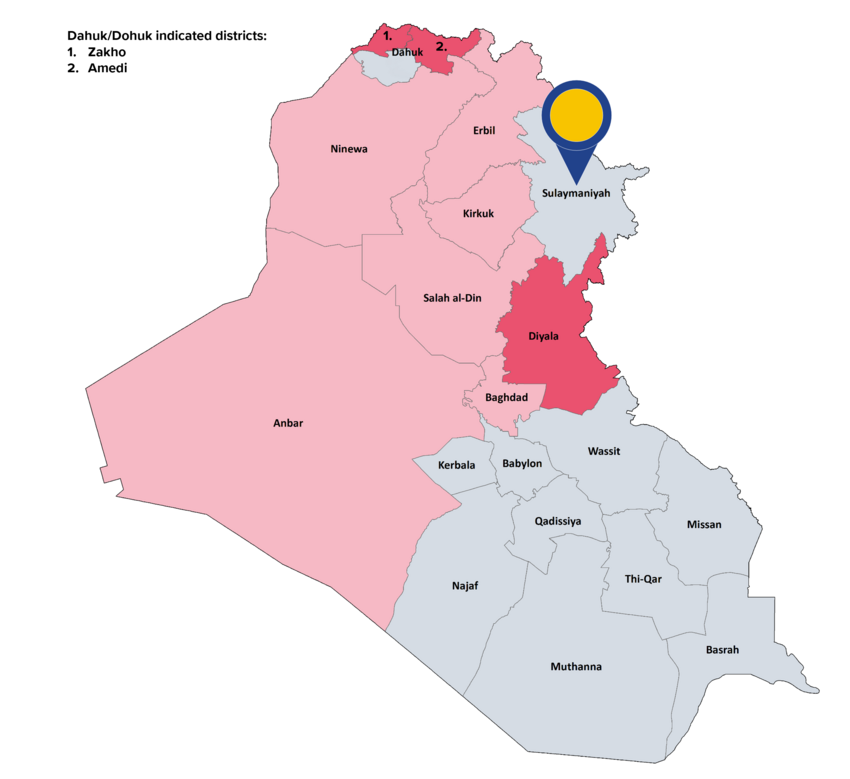COMMON ANALYSIS
Last update: June 2022
General information
Sulaymaniyah governorate is part of the KRI and is located in the northeastern part of Iraq. It borders Erbil, Kirkuk, Salah al-Din and Diyala, and shares an international border with the Islamic Republic of Iran to the east. Sulaymaniyah governorate is divided into the following districts: Chamchamal, Darbandihkan, Dokan, Halabja, Kalar, Penjwin, Pshdar, Rania, Sharbazher, and Sulaymaniyah. The Government of Iraq still considers Halabja part of Sulaymaniyah governorate. The Garmiyan region is a disputed territory between Iraqi and Kurdish forces. The capital of the governorate is Sulaymaniyah city. The Iraqi CSO estimated the governorate’s population for 2021 at 2 336 191 of which 1 979 000 live in urban areas. The main ethnic group in the governorate are Kurds.
Background of the conflict
The overall stability in the KRI depends on the nature of the relationship between the Kurdistan Democratic Party (KDP), which controls Erbil and Dohuk and the Patriotic Union of Kurdistan (PUK), which controls Sulaymaniyah. The cooperation between both parties appears to be difficult.
The PKK fled Turkey and arrived in Iraq in 1980. The KRG is closely linked to Turkey concerning various economic matters and accepted Turkish operations against the PKK taking place in the KRI. Sulaymaniyah’s security situation is relatively stable since 2003. The conflict between PKK and Turkey affected the eastern mountain range where several military operations were conducted. In October 2021 PUK called for an immediate halt of border transgression by Turkish forces. As of December 2020, Kurdish opposition parties got shelled by Iran’s Revolutionary Guard Corps (IRGC) on several occasions. The KRG is confronted with an economic crisis, which led to widespread protests in the KRI as well as in Sulaymaniyah, some of which escalated and resulted in injuries and deaths.
Actors: control and presence
Peshmerga units (KDP or PUK linked) and Peshmerga brigades of the Ministry of Peshmerga Affairs (MoPA) are present. Asayish internal security services (KDP or PUK linked) and separate intelligence services (Zanyari (PUK) and Parastin (KDP)) can be found. They are loyal to their affliated parties and involved in the day to day security and administrative affairs. The militarised police forces, Zerevani, were present as well.
The ISF and the Peshmerga forces established joint units in the fight against ISIL in the disputed territories between the KRI and the Iraqi government.
Turkish military forces carried out several attacks in the governorate, in several districts.
PKK is present in the areas bordering Erbil and Iran. It has been reported that around 650 communities might live under PKK control throughout the KRI. PKK has approximately 5000 fighters stationed in the KRI and has its headquarters in the Qandil mountains.
Iran deployed forces to Sulaymaniyah governorate border and trespassed the border on multiple occasions.
The PJAK, an Iranian Kurdish armed group opposed to Iran is reportedly based in the Quandil mountain, not too far from the Iranian border.
Nature of violence and examples of incidents
Peshmerga and Asayish forces are responsible for and are involved in the day-to-day security, such as the controlling of the protests. Both acted against the law and conducted arbitrary arrests. Asayish internal security services have impunity regarding human right violations. They conducted security operations in the fight against ISIL.
During the reference period, 40 explosions were recorded, of which more than the half were related to Turkish airstrikes. A smaller part of the recorded explosions was related to attacks of unidentified armed groups, unidentified explosive devices and explosive remnants of war.
Turkish military forces carried out several attacks in the governorate, occasionally causing civilian casualties and material damage, including the destruction of farms or causing fires.
Shelling of KRI’s mountains by the Islamic Revolutionary Guard Corps (IRGC) that targeted Kurdish opposition parties were reported in the governorate.
Incidents: data
In the reference period, ACLED reported a total of 68 security incidents (average of 1 security incident per week) in Sulaymaniyah of which 40 were coded as remote violence/explosions, 17 as violence against civilians and 11 as battles. UNAMI[42] recorded 3 armed conflict-related incidents, 2 taking place from 1st August to 31 December 2020 and 1 from 1st January until 31 October 2021.
Geographical scope
All the districts of Sulaymaniyah are affected by security incidents, the majority of which, occurred in the district Pshdar and Sulaymaniyah.
Civilian casualties: data
UNAMI recorded no casualties in the reference period.
Displacement
As of 30 September 2021, 140 237 IDPs are registered in Sulaymaniyah governorate. No IDPs originating from Sulaymaniyah governorate were registered in other parts of the country and no returns to Sulaymaniyah were recorded.
Further impact on civilians
Turkish military operations caused material damage, such us the destruction of homes, farms and agricultural land. The KRI including Sulaymaniyah has a high mine infection rate.
|
|
Looking at the indicators, it can be concluded that in the governorate of Sulaymaniyah there is, in general, no real risk for a civilian to be personally affected within the meaning of Article 15(c) QD. |
Main COI references: Security 2022, 2.9.2, 2.10

[42] UNAMI data focuses on armed conflict-related incidents, which have directly impacted civilians (causing civilian casualties) and the civilian nature of property and protected areas (such as civilian houses, cropland, schools, health facilities and mosque), see ‘Indicators of indiscriminate violence, number of incidents’.
